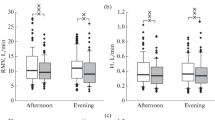Abstract
The effects of daily and weekly academic loads on the psychological and cardio-and hemodynamic characteristics of students were analyzed. The self-estimated state of health, activity, and mood were evaluated with the use of the HAM (Health-Activity-Mood) questionnaire; the introversion and extraversion, neuroticism, and intelligence of the subjects were determined according to Eysenck; and the self-estimate the personal anxiety according to Spielberger, was evaluated. The main hemodynamic parameters (heart rate and arterial blood pressure) were measured and the systolic and minute blood volumes were calculated. The comparison of the dynamics of the parameters studied showed that there were two types of response of the students’ cardio-and hemodynamic parameters to academic load: sympathetic and parasympathetic. The parasympathetic response was found to be more adequate because the sympathetic response entailed the risk of overstrain and adaptation failure.
Similar content being viewed by others
References
Nozdrachev, A.D. and Shcherbatykh, Yu.V., Modern Methods of Functional Studies of the Autonomic Nervous System, Fiziol. Chel., 2001, vol. 27, no. 6, p. 95 [Hum. Physiol. (Engl. Transl.), vol. 27, no. 6, p. 732].
Sitdikov, F.G., Shaikhelislamova, M.V., and Valeev, I.R., The Effect of Academic Load and Work Conditions on the Sympathoadrenal Function and the Indices of Heart Rhythm Regulation in 17-to 18-Year-Old Girls, Fiziol. Chel., 2001, vol. 27, no. 5, p. 60 [Hum. Physiol. (Engl. Transl.), vol. 27, no. 5, p. 561].
Shcherbatykh, Yu.V., Self-Regulation of Autonomic Homeostasis in Emotional Stress, Fiziol. Chel., 2000, vol. 26, no. 5, p. 151 [Hum. Physiol. (Engl. Transl.), vol. 26, no. 5, p. 641].
Yumatov, E.A., Kuz’menko, V.A., Badikov, V.I., et al., Emotional Stress in Students during Examinations, Fiziol. Chel., 2001, vol. 27, no. 2, p. 104 [Hum. Physiol. (Engl. Transl.), vol. 27, no. 2, p. 221].
Agadzhanyan, N.A., Ruzhenkova, I.V., Starshinov, Yu.P., et al., Characteristics of Adaptation of the Cardiovascular System in Adolescents, Fiziol. Chel., 1997, vol. 23, no. 1, p. 93 [Hum. Physiol. (Engl. Transl.), vol. 23, no. 1, p. 82].
Sidorov, P.I., Solov’ev, A.G., and Novikova, I.A., Psychosocial Maladaptation of Students with Chronic Somatic Pathology, Gig. San., 2001, no. 4, p. 46.
Gevorkyan, E.S., Dayan, A.V., Adamyan, Ts.I., et al., The Effect of Exam Stress on Psychophysiological Parameters and Heart Rate in Students, Zh. Vyssh. Nervn. Deyat., 2003, vol. 53, no. 1, p. 46.
Gevorkyan, E.S., Dayan, A.V., Adamyan, Ts.I., et al., Changes in Some Psychophysiological Parameters of Students during Exams, Gig. San., 2002, no. 3, p. 41.
Baevskii, R.M., Kirillov, O.I., and Klitskin, S.Z., Matematicheskii analiz izmenenii serdechnogo ritma pri stresse (Mathematical Analysis of Heart Rate Changes in Stress), Moscow: Nauka, 1984.
Vanyushin, Yu.S. and Sitdikov, F.G., Adaptation of Cardiac Performance to Physical Exercise of Increasing Power in Adolescents, Fiziol. Chel., 2001, vol. 27, no. 2, p. 91 [Hum. Physiol. (Engl. Transl.), vol. 27, no. 2, p. 210].
Navakatikyan, A.O. and Kryzhanovskaya, V.V., Vozrastnaya rabotosposobnost’ lits umstvennogo truda (Age-Related Working Capacity of Persons Engaged in Mental Work), Kiev: Zdorov’e, 1979.
Rubanovich, V.B., Girenko, L.A., and Aizman, R.I., Characteristics of the Morphofunctional Development of 7-to 14-Year-Old Boys with Different Types of Adaptive Response, Fiziol. Chel., 2003, vol. 29, no. 3, p. 48 [Hum. Physiol. (Engl. Transl.), vol. 29, no. 3, p. 301].
Dotsoev, L.Ya., Usynin, A.M., Vagner, N.I., et al., Functional State of 11-to 12-Year-Old Schoolchildren under Conditions of Intense Academic Load Assessed by Heart Rate Variability, Fiziol. Chel., 2003, vol. 29, no. 4, p. 62 [Hum. Physiol. (Engl. Transl.), vol. 29, no. 4, p. 444].
Antropova, M.V., Kuznetsova, L.M., Manke, G.G., et al., Morphofunctional Maturation of Preschool Children during Early Systematic Education, Fiziol. Chel., 2003, vol. 29, no. 3, p. 41 [Hum. Physiol. (Engl. Transl.), vol. 29, no. 3, p. 295].
Author information
Authors and Affiliations
Additional information
Original Russian Text © E.S. Gevorkyan, S.M. Minasyan, Ts.I. Adamyan, A.V. Dayan, N.N. Ksadzhikyan, 2006, published in Fiziologiya Cheloveka, 2006, Vol. 32, No. 4, pp. 57–63.
Rights and permissions
About this article
Cite this article
Gevorkyan, E.S., Minasyan, S.M., Adamyan, T.I. et al. Dynamics of the integrated characteristics of heart rate variability and psychophysiological parameters of students under the conditions of daily and weekly academic loads. Hum Physiol 32, 423–428 (2006). https://doi.org/10.1134/S0362119706040074
Received:
Issue Date:
DOI: https://doi.org/10.1134/S0362119706040074




